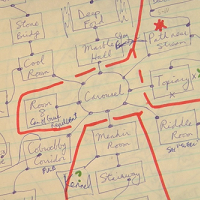On Thursday, December 28, 2023, I published new walkthroughs for the games and stories listed below! Some of these were paid for by my wonderful patrons at Patreon. Please consider supporting me to make even more new walkthroughs for works of interactive fiction at Patreon and Ko-fi.
THE RUIN OF 0CEANUS PR1ME (2023) by Marco Innocenti
In this sci-fi horror game, you play as Colonel J.T. Thomas investigating the ruins of an underwater research facility on Saturn’s moon, Titan. Biofarm wants something called 73-Jon, and it’s your job to find and retrieve it. Lucky you.
Content warnings: foul language, physical and psychological abuse of children and animals, drug abuse.
This game was an entry in PunyJam #4 where it took NTH place. It is also a sequel to A1RL0CK, also by Marco Innocenti.
The Haunting of Corbitt House (2023) by Arlan Wetherminster
In this game set in Baltimore, you play as the detective. A dark-haired beauty walks into your office with a case: she thinks her inherited tenement house may be haunted. You need the rent money, so you agree to investigate.
This game was an entry in Le Grand Guignol division of Ectocomp 2023 where it took 17th place.
IFDB | My walkthrough and maps
SpAdventure (1996) by Jay Walton
This variant of the 350-point version of Adventure includes Balances-style spells like frotz and rezrov. You are a spellcasting adventurer. Explore the caves, find all 15 treasures, deposit them in the building, and maximize your score.
IFDB | My walkthrough and maps
Cargo Breach (2023) by Garry Francis
In this game set during World War I, you play as a British sailor aboard the SS Cuttlefish. As you slept, a cargo breach of chlorine gas killed everyone else on board, and the ship is adrift. Find your gas mask, save yourself, and prevent the gas from killing anyone else.
This game was an entry in PunyJam 4 where it took NTH place.
Bus station (2009) by Alex Mitchell
In this short story, you are waiting at the bus station for the last bus to Montreal to visit your parents. But there’s a blizzard outside and you don’t have your ticket or any money. Three possible endings.
This short story was a participant in the Interactive Fiction Writing Month event of February 2009.
Octopus’s Garden (2009) by Michael D. Hilborn
In this small game, you play as a woman’s pet octopus, and your aquarium sits on an ornate table in her apartment’s bedroom. You once loved the view of the city from the nearby window, but you’re bored with it now. Convince your owner to move. You need a change of scenery.
This work was a participant in the Interactive Fiction Writing Month event of February 2009.
Pharaoh (2023) by Gianluca Girelli
In this short linear game, you and your family were touring the Great Pyramid of Giza complex when the walls started shaking, a green vortex appeared, and your guide ran off, leaving you all in darkness. You need light, and you need to find a way out.
This game was an entry in PunyJam #4 where it took NTH place.
Vampire Gold (2023) by Olaf Nowacki
In this small generic RPG, you play as an adventurer in search of treasure. Defeat monsters, improve your armor and weapons, then kill the vampire to win the game.
This work was an entry in the La Petite Mort (English) division of Ectocomp 2023 where it took 11th place.








